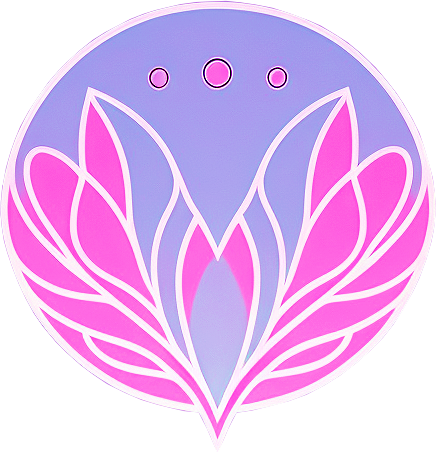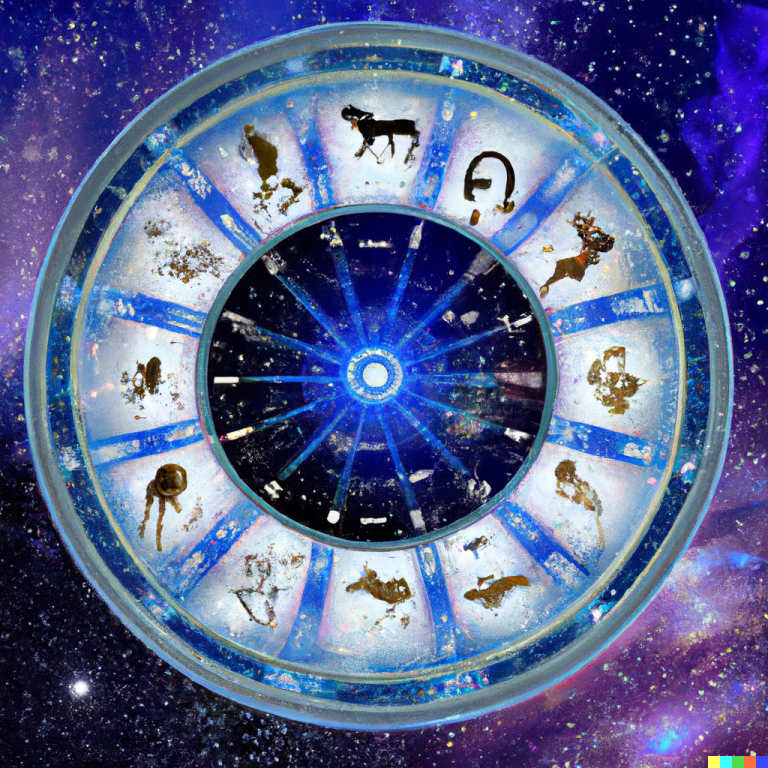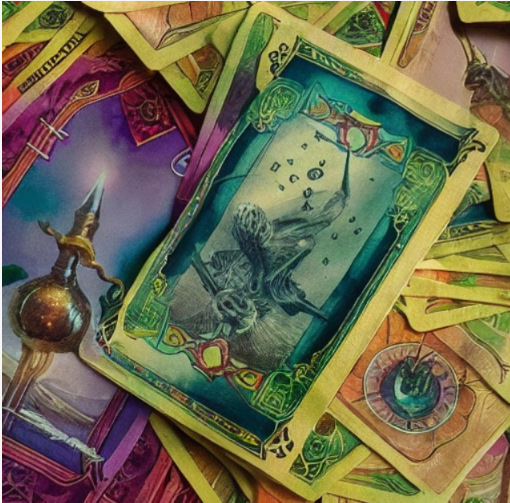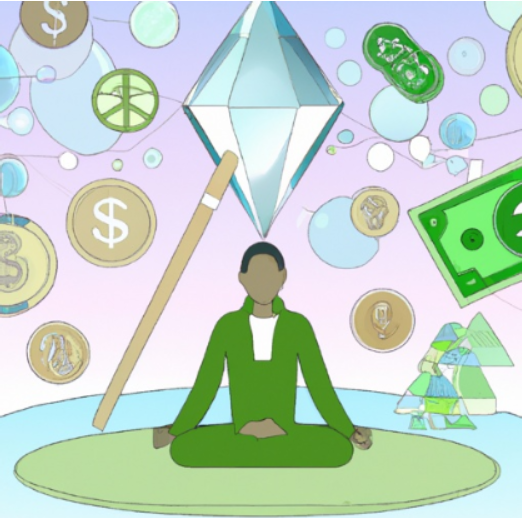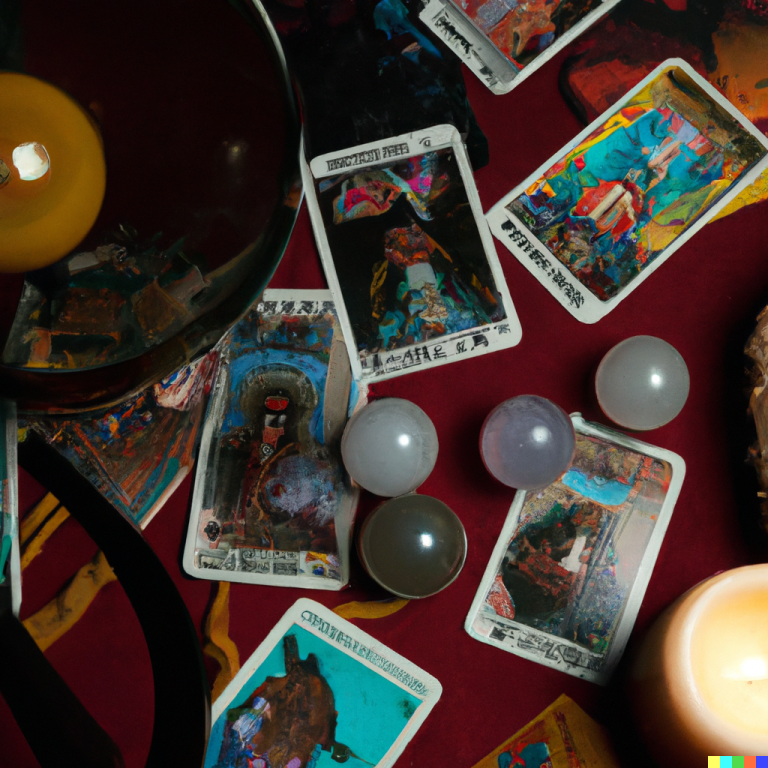Think of the 4 tarot suits as the fab four of the tarot world, each with its distinct personality and style. They’re like the Spice Girls of the tarot realm, bringing their unique flair to the reading party. From fiery wands to emotional cups, practical pentacles to intellectual swords, these suits are the tarot’s version of a super squad, ready to reveal the mysteries of the universe, or at least offer some guidance on life’s everyday dilemmas.
But don’t worry, you won’t need a crystal ball or a magic wand to make sense of it all. We’ll break down the symbolism, meanings, and quirks of each suit in a way that’s relatable and easy to understand. So, whether you’re a tarot novice or a seasoned reader looking to brush up on your skills, get ready to embark on an adventure into the world of tarot suits like never before.
Numerology and the suits
Unlike the Major Arcana, the Minor Arcana are grouped by suite and subdivided by numbers. Thus, for each suit, you will have cards ranging from Ace to 10 (thus from 1 to 10) as well as a jack, a knight, a queen and a king. However, it is not necessary to learn by heart the meaning of each of these cards, and this, for each suite… it still makes a total of 56 cards…
In fact, it is enough to know what each number corresponds to in the numerological system and to combine this meaning with that of the sequence (we will get to that later) and of course, with your own intuition.
1 or Aces : a new beginning
When you face an Ace, it means you are facing a new beginning. It can be a new project, a new idea, a new sentimental interest, etc. The idea is that the 1 symbolizes something new that has just appeared in the consultant’s life. It is a new stage that begins and it is up to the consultant to decide whether to start or not.
2: duality
With the two, you are faced with the notion of duality. And it can literally be in any field or situation. A choice to be made between two options, the bringing together of two partners, a hesitation or a problem balancing two things. What must be remembered is the notion of uncertainty in relation to novelty. The 2 coming just after the 1, which symbolizes novelty, this duality symbolizes in most cases a choice to be made.
3: Creation
With the 3, we speak of novelty, something new has just happened or will happen in the life of the consultant. Attention, who says novelty does not necessarily mean positive or final decision. After the 2 which often leads to questioning, it is now a question of looking towards the horizon and towards the different possibilities offered. We are only talking about a new element that enters the life of the consultant.
4: stability and foundations
With the 4, we tend towards a notion of stability. It is about planning and thinking about how it can be possible to build solid foundations to achieve a new balance. After the 3 that brings the seeker to face newness, now is the time to consider how these new things can lead to a new normal. The notion of introspection is often topical when the number 4 appears. Does the consultant manage to grasp all of what is offered to him, or does he fail to see certain possibilities through a limited vision of things?
5: changes and conflicts
With the 5 there is change on the horizon…but who says change often says conflict. Internal conflicts or with others, conflicts of interest or morals. The 5 is a card representing an obstacle to change, something to be overcome for the consultant to reach his goal. If the 4 leads the consultant to question how he can take a new step, the 5 represents the most difficult periods to live on the path to success.
6: harmony
With the 6, harmony begins to be accessible. It is not a question of having reached perfect harmony, but of a step towards this harmony. The 6 is a card that promises success if the consultant undertakes a certain journey and pursues a specific path. The conflicts of the 5 having been settled, it is now necessary to take the first step towards harmony. The most important work remains to be done, but the journey is well underway.
7: spirituality and knowledge
The 7 leads the consultant to question his choices, his methods and the way he wishes to achieve his objectives. The 7 is a card that encourages perseverance and the continuation of the journey. If the 6 leads the consultant to begin to take action to achieve harmony, the 7 represents the choices that the latter will have to make before taking action. This is the decision stage and these decisions, only the consultant can make them. The maps only show the possibilities.
8: action
With the 8, the consultant is led to take action. 8 is the achievement card. If the 7 led to questioning, the 8 pushes to the final decision-making. Nothing happens without effort and this card reminds the consultant that although things are on the way, that the process is well underway, we must not stop working to achieve success.
9: accomplishments
After the sustained efforts encouraged by the 8, the 9 represents accomplishment. Finally, the results are tangible and accessible. Whether these results are positive or negative, they are the fruit of the choices and actions undertaken by the consultant. This is also a final stage of questioning. Are the results satisfactory or not? If yes, then efforts must be continued, but if the answer is negative, then a correction is necessary.
10: final realisation
The 10 is the end result card. After a long journey, the consultant finally arrives at something tangible. This is the logical next step. If the efforts have been constant and the necessary work has been done, then it is the celebration. If, on the contrary, the path was difficult and the choices bad, it may well be that the 10 is not the success we hoped for. In either case, it is the end of the journey and the consultant must then decide if he is satisfied or if he wants to start over.
Figures
The figures can represent either people (the consultant or people around him) or different types of energy. It is then up to the reader to identify, depending on the question, the other cards drawn and their own intuition, which one best suits the situation.
Page
The page is a young, somewhat naive person who timidly undertakes something. This is the novelty. It is a new energy, fresh and curious. The page embodies the beginning of an adventure, a process or a journey. It is something recent, an energy or a person who has just entered the picture. By his naivety and his desire for new adventures, the page is enthusiastic, motivated and full of creative energy.
Knight
The knight is a being of action. Intrepid, he embarks on a new adventure, eager to discover new things and experiences. It is a fiery and vivacious energy. However, the knight is still immature, he is fickle, and inconstant. If he is motivated, however, he sometimes loses this motivation and withdraws. The knight is a strong, driven, but unstable person or energy. It is about the ardor of youth which is sometimes unpredictable and cannot always be relied upon.
Queen
The queen is a being who commands respect by her presence. She embodies the strong feminine energy, which receives and observes, but which imposes itself with its power. The queen is a regal, yet reassuring person or energy. She is not necessarily in the action, but dominates and one cannot help noticing her. She is mature and comforting, no matter what form she takes.
King
The king is the authority figure par excellence. It is a stable person or energy. We can always count on the king to be present when we need him. It is the emblem of success and balance. He is a being or an energy of action, but unlike the knight, the action of the king is constant and he will never disappear for lack of motivation.
The 4 suits
In the traditional tarot deck, there are four suites: the suite of wands, pentacles, cups and sword. Each suite has an element, a sign and a story. To understand the story of the sequel is to understand its significance.
By combining the sequence with the number of the card or its figure, it is then possible to obtain a meaning, without having to learn each card by heart.
The suit of Wands
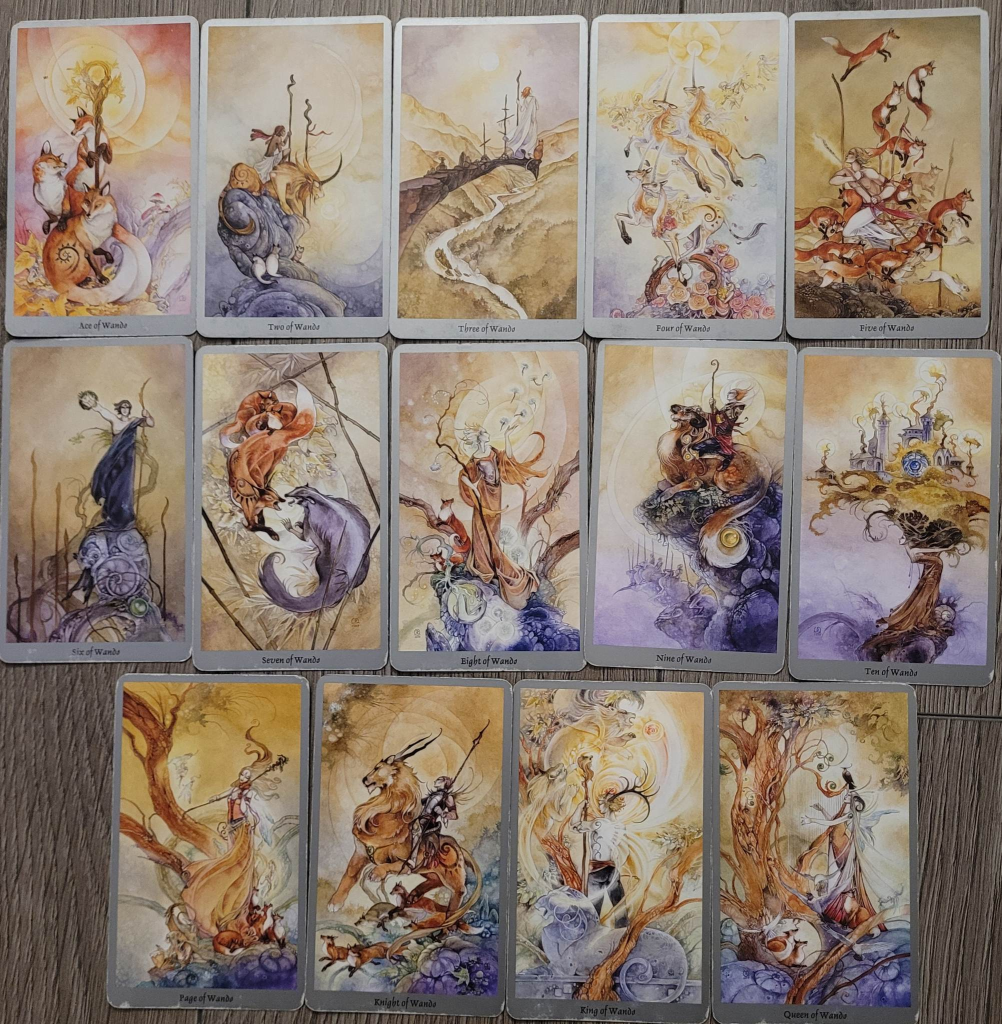
Element: Fire
Astrological signs: Aries, Leo and Sagittarius
The story of the suit of wands is one of action. Generally, the cards in this suite refer to the action and planning that precedes those actions. They tell the story of the birth, planning and implementation of a project.
The Ace of Wands represents the first urges to get into action. It is the beginning, the first will to want to act, to want to accomplish something. The consultant wants to move and realize any project. It’s about the pure creative energy that inspires you to jump headfirst into a new adventure…and why not? This card is the symbol that the consultant must launch and concretize his long-standing projects. If he needed a sign that now is the right time to act, here it is!
The 2 of Wands represents this desire to want to set up something. The consultant then begins to plan and put some ideas on paper. It’s still abstract plans, it’s a first brainstorm. This is the stage where the consultant is for the first time called upon to move away from his comfort zone. Having an idea is one thing, but actually starting to plan for it is another. These are the first risks, or at least the first time that the consultant finds himself faced with the idea of risk and the consequences that this could have, both good and bad.
The 3 of Wands represents the desire to finally explore new horizons. Once the first plans are put on paper, the consultant looks to the future and the possibilities it contains. After the thoughts of the 2 of wands, now is the time to get into action and test the first plans. After having built a solid foundation in theory, the consultant must now open up to the opportunities that surround him and seize them. It is the beginning of a journey, of a new adventure, of a journey that leads the consultant from his traditional routine, from his home and to embrace the world around him.
The 4 of Wands represents the first success. The consultant is motivated and celebrates his first accomplishments. This is a celebration and gathering card. After having discovered and acted on the possibilities of the 3 of Wands, the consultant then wants to celebrate the accomplishment of a first important step in his journey and he wants to do it with the people around him. However, you also have to ask yourself if this is not an early celebration, because sometimes there is a tendency to rejoice too quickly and ignore the warning signs that all is not in fact. as perfect as it seems. It is human nature to want to imagine that everything is won at the first positive result. The 4 of Wands signals a first accomplishment, but warns the seeker not to put on blinders.
The 5 of Wands represents the first conflicts. Because in any project, the consultant will inevitably encounter the opposition of others, or even have to face his own internal contradictions. If the consultant gets too easily carried away by the energy of the 4 of Wands, then he risks finding himself in conflict, because he will then probably have ignored the opinion of those also involved in his projects. Communication is essential and the 5 of Wands demonstrates a flagrant lack of communication, where everyone is for themselves or on the contrary, where everyone wants to express themselves without listening to the others.
The 6 of Wands brings success back to the seeker’s life. After the confusion and the lack of communication of the 5 of Wands, the consultant sees his accomplishments recognized in a public way. His efforts begin to bear fruit and the validity of his project is recognized by more people. The constancy of the efforts and the constancy through the obstacles led the consultant to this success which is again celebrated. This card represents a joyful stage where the light begins to be seen again after the obstacles and conflicts. The consultant is on the road to success and if he continues on the same path, he will see his efforts rewarded by the achievement of his objectives.
The 7 of Wands is a reminder that if the consultant wishes to maintain the trend towards success of the 6 of Wands, he must not stop working. Many people slack off once their efforts start paying off. However, known success has come through hard and constant work and if this work is not continued, then the consultant risks falling back into the conflicting energy of the 5 of Wands. The consultant must maintain the ground gained and not give up on the first obstacle encountered. Now that the project is experiencing a first wind of success, we must stay the course.
The 8 of Wands suggests that the consultant has managed to maintain consistency and satisfactory effort to overcome various obstacles and bring his project to a certain level of stability. If the trend continues, then the project will likely experience further growth very soon. The consultant learned well the lessons of the 7 of Wands which called him to continue his efforts and reach a constant level of work. The 8 of Wands encourages the seeker to be patient and continue the work they have done so far, because they are about to reach a point where everything will reach a momentum that will bring a higher rhythm allowing the seeker a guarantee long-term success.
The 9 of Wands represents hope for a better future. After the 8 of Wands where the seeker has reached a satisfactory level of success and a constant rate of progress, the 9 of Wands reminds him that all will not always be rosy. Obstacles will continue to arise and it is up to the consultant to remember that their efforts will always be rewarded in the end. Determination will always overcome the most difficult moments and the seeker will only come out of his ordeals stronger. Even if a project is a success that may prove to be sustainable in the long term, this sustainability will only be ensured by renewed perseverance in the face of daily challenges.
In the end, the 10 of Wands comes as a warning. After having built a project that has been successful, having gained consistency and recognition from his peers, the consultant finds himself at the head of a rewarding project, but which can also become a burden if certain precautions are not taken. If the 9 of Wands refers to perseverance, the 10 of Wands reminds the consultant that it is useless to undertake more than he can really accomplish, because in the end, he will only succeed in exhaust in vain. After having experienced success, it is easy to always want to take on more, but too many tasks can lead to physical and moral exhaustion as well as to even greater success.
The Page of Wands represents an individual full of enthusiasm, energy and projects. He has all sorts of things in his mind that he wants to accomplish and can’t wait to get to work. This card is a sign for the consultant to use this vibrant and exciting energy to get to work and begin their many projects. The valet of wands is however inexperienced and this scares him a little. However, he must overcome this emotion if he really wants to be able to accomplish what is important to him. After all, everyone has to start somewhere and the consultant must remember that everything must inevitably start with a first action.
The Knight of Wands represents the evolution of the Page of Wands. It is an active and driven person or energy, although not necessarily reliable. Once launched, the consultant finds himself in the heat of the action. He found the courage to undertake his project and is now in the creative phase. Be careful, however, not to undertake too much at once! The fearlessness of the knight can sometimes lead him to want to start too many things at once and he may eventually become discouraged when faced with too much work. This energy must be channeled otherwise it will only be ephemeral. This is why the knight represents both fast action, but also unstable due to the immaturity of the character.
The Queen of Wands represents a person or energy possessing unwavering focus and an electrifying aura. She is very optimistic about the future and people find themselves naturally drawn to her. They know that they will find in her a sure, reassuring, but also motivating figure. She is able to take on a large workload and get it done in a short time. This is an effective person who does what he has to do and leads others in his own success.
The King of Wands represents a being or an energy of action. He fully assumes his desires and does not hesitate to do what it takes to get what he wants. Unlike the knight who acts but is not always consistent, the king is someone you can count on. When he promises something, he does it. You will never have any doubts about the intentions of the King of Wands, because he makes them known and always follows the word with action. He is a leader, someone who likes to take on new projects and bring them to fruition.
The suit of Pentacles

Element: earth
Astrological signs: Taurus, Virgo, Capricorn
The suit of pentacles is for material goods and finances. The cards usually refer to career opportunities, money, and abundance. They tell the story of wealth, both material and personal.
The story of the suite begins with the Ace of Pentacles. This is the birth of a new opportunity. It can be both professionally and financially. The Universe sends the seeker an opportunity that may well bring them renewed abundance, a new flow of money or a new career path. However, it is up to the consultant to make the decision to seize the opportunity or not.
This dilemma brings the consultant to the 2 of pentacles. After facing several new opportunities with the Ace of Pentacles, the seeker must choose and find a balance. This card represents indecision, the difficulty of swinging several opportunities. It encourages the consultant to focus on what concerns him the most, generally 2 important aspects of his life (career, finance, love). In order to find a balance, it will be necessary to focus on the advantages and disadvantages of the situation and if a balance cannot be found, then a choice will have to be made.
The 3 of Pentacles reminds the consultant that he is not alone, who is surrounded by people on whom he can rely. It is in teamwork that many objectives can begin to be achieved. By combining his abilities with those of others, the seeker can then begin his path to success. Collaboration with others is sometimes essential to achieve a goal more quickly and efficiently than alone. This card also reminds the consultant that he has a social group that can advise him in the choices brought about by the 2 of Pentacles.
The 4 of Pentacles comes as a warning. After having collaborated and benefited from the energy of the 3 of Pentacles, the consultant finds himself in an advantageous position. Abundance is there, but you have to be careful not to close in on yourself. After a success, a tendency to avoid the risk or to share this success can be set up. However, this is not how a constant cycle of abundance will be established. This card warns the consultant against isolation, fear of risk, even greed. Keeping some things to yourself can be beneficial, but you have to know not to go overboard.
The 5 of Pentacles represents the obstacles on the path to abundance. It could be financial problems, old debts, job loss, or just feeling isolated and destitute. This card indicates to the consultant that an update is needed in order to end this difficult period. The 5 of Pentacles also indicates a glimmer of hope. All is not lost. If the problems are quickly identified and taken care of, then it will be possible to cross the threshold and move towards better horizons. To do this, he needs to get out of the energy of the 4 of Pentacles and start opening up again to others and to the possibilities that the Universe sends.
The 6 of Pentacles symbolizes the gradual return to balance. After the obstacles of the 5 of Pentacles, this card indicates to the consultant that he must now question the balance of his situation. Is it one where everyone receives and gives equally or is there one party that gives more than another? In order to find satisfaction, it is essential to have an equal energy exchange in everything that is undertaken, otherwise bitterness will set in. The consultant must then ask himself if he is the one who gives too much or receives too much and make the necessary corrections.
The 7 of Pentacles is an indication that the seeker is on the right path and has restored any inequalities that the 6 of Pentacles may have raised. If he has not yet achieved the abundance he seeks, his efforts have not gone unnoticed and are beginning to be recognized. So don’t give up now. If sometimes success and abundance are slow to really be seen, that does not mean that you have to give up at the slightest obstacle. This card reminds the seeker of the value of consistent effort and how it can lead to success…if not abandoned along the way.
The 8 of Pentacles symbolizes relentless and constant effort. This card demonstrates that the consultant is dedicated to his task and is ready to invest the work necessary for the realization of his projects. The consultant retained and applied the lessons of the 7 of Pentacles and established a constant work cycle. However, we must not forget the lesson of the 3 of pentacles. If the work turns out to be too heavy, asking for support from others is the solution, otherwise, it is guaranteed exhaustion. The 8 of Pentacles represents action towards success, but also the different types of support and support that are hidden behind this success.
The 9 of Pentacles represents personal achievement. Following the efforts and actions of the 8 of Pentacles, the consultant has succeeded in reaching the level of abundance that allows him to be comfortable and to appreciate his situation. This card represents security and personal stability. The obstacles are a thing of the past and it is now possible to appreciate the fruits of the efforts invested. The 9 of Pentacles symbolizes the importance of first being at peace and in harmony with the present situation before trying to share it. If happiness cannot be enjoyed alone, then it will often be impossible to enjoy it with others.
The 10 of Pentacles symbolizes stability and future abundance. After many efforts, the consultant has now reached an advantageous level of material and personal wealth that he will be able to share with the people around him for several years. It is the ultimate accomplishment, one that lasts over time and brings pride and balance. The consultant has been able to put in place a situation that ensures comfort, stability and renewable success in the long term. Once the lesson of the 9 of Pentacles has been learned, now is the time to enjoy success with loved ones.
The Page of Pentacles represents an individual or new energy, who desires to embark on a quest for abundance and start a project that will bring many riches. If the Page of Pentacles does not yet know where to start, he has the necessary motivation to begin a new chapter that can bring him material and personal success. He is excited by the idea of a new adventure and is determined to know success. He is the model student, the one who is always present and ready to try something else. He is motivated by the success of others and also wants to build his own empire that will benefit him in the long term.
The Knight of Pentacles represents a working individual or energy. He is what the valet can aspire to become if he keeps up his efforts. He is someone who works hard on a daily basis. He is invested in his routine and can generally be reliable. However, it is not yet a mature energy. Sometimes inconstant, the Knight of Pentacles sometimes reaches extremes, sometimes becoming sickly perfectionist when he cuts corners another time. It is, however, a go-getter and represents an energy or individual that is on the right path to success. Through effort, he will eventually come to the maturity necessary to establish a stable routine and constant effort.
The Queen of Pentacles represents an individual or energy that can be trusted. Reassuring, she is both the one who takes care of her home and makes it warm, while being an infallible businesswoman. The Queen of Pentacles is not necessarily the most emotional, but she has boundless devotion to those she loves and she will do everything to ensure that their material and financial needs are met. It is about someone who has lived and who transmits good advice to those around him so that they in turn can make informed decisions. The queen is benevolent and represents someone who has succeeded financially, without flaunting her success.
The King of Pentacles represents an individual or energy that has achieved the epitome of financial and material success. He persevered and succeeded in everything he undertook, now leading him to be a stable and secure figure. However, the King of Pentacles is not like the Queen. If he’s been successful in life, he likes to show it off and can sometimes give direct advice that can seem harsh. This is not out of ill will, however, as all he wants is to help others achieve the success he has achieved. He is often the biggest supporter of those around him and desires to be a mentor that others can follow. It is a symbol of stability and financial security.
The suit of Swords
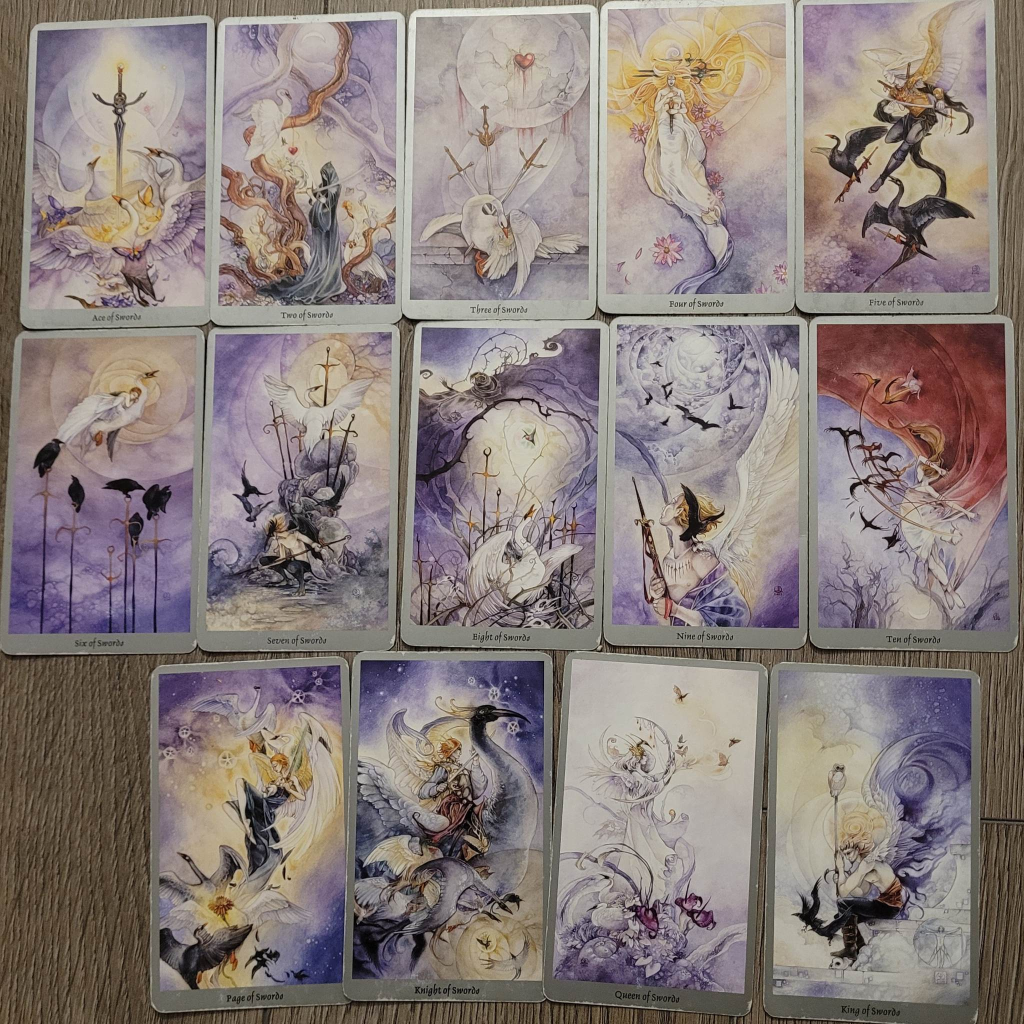
Element: air
Astrological signs: Gemini, Libra, Aquarius
The story of the suit of swords is a slightly more tragic one. The cards represent that which relates to the mind and thoughts. They tell the story of what can happen if the seeker lets their mind and think they have the best of themselves and fails to channel them adequately.
The Ace of Swords represents the emergence of an idea. This is the stage where a project, a person, a dream arises in the mind of the consultant. Although the thought is still embryonic, this is the stage where the imagination takes flight and where it is possible to begin to envision what could, or could not be. This is where all construction begins, with a new thought, an idea. However, this new idea, no matter how exciting, is often the source of obstacles created by the imagination itself.
The 2 of Swords represents a choice to be made. As after any beginning of projects, the consultant finds himself faced with several options brought by the Ace of Swords, often two main ones between which he hesitates. What makes this choice even more difficult is the set of possibilities that the mind has fun creating if the balance tips one side or the other. It even happens that these obstacles, these choices only exist purely in the mind of the consultant. However, a decision will have to be reached if the ultimate goal is to be realized.
The 3 of Swords represents what happens when the choices made in the energy of the 2 of Swords are not the right ones, or when they lead to unenviable situations. This card represents the broken heart, where the mind does not envision a happy ending. Again, this is the tragedy of the sword suite, because quite often it is the very thoughts of the consultant that prevent them from seeing the big picture and the possible solutions that could lead them towards a happier future. Broken hearts mend and come to love and trust again. They do not symbolize the end, but rather a set of new and more advantageous possibilities.
The 4 of Swords represents this stage of withdrawal after the unpleasant situation of the 3 of swords. It is a period of introspection where the consultant is called upon to gather his thoughts and develop a new action plan. This card symbolizes mental, spiritual and physical withdrawal, a stage of rest and solitude essential to start on the right foot. This is an opportunity to heal your wounds and examine the different paths available. There is no hurry, it is a moment of contemplation where the consultant is invited to take time for himself and find himself.
The 5 of Swords represents this period of mental confusion that can follow the rest period of the 4 of Swords. It is the fear following failure where the mind starts thinking and imagining all the future obstacles. This card represents the inner conflict, but also the outer one. When the wounds are still fresh, it can happen that the reactions to certain situations are not appropriate and hurt other people. This is also a warning. After thinking about the 4 of Swords, you have to be careful not to start overambitious to make up for lost time. Everything in its time.
The 6 of Swords represents letting go. After the period of internal and external conflict of the 5 of Swords, it is time for the consultant to leave behind this troubled phase and turn to a new beginning and calmer waters. In order to move forward, the consultant is called upon to leave behind his pain in order to be able to undertake new projects that will bring him new happiness. Sometimes you have to use logic and reorganize your thoughts to get to that stage where it will be possible to face the future without having to ruminate on the past.
The 7 of Swords represents the period of doubt before a new beginning. If the 6 of Swords invites you to let go, the 7 of Swords symbolizes all the doubts that the consultant will have to face in his journey towards a better future. Because the wounds of the past are not so easily forgotten and it happens that they resurface when it is necessary to have confidence again, confidence in oneself, but also in others. This card also pops up as a warning. The consultant must not let his doubts have the upper hand or he risks betraying himself in his own will to move forward, if he does not come to betray someone else in the process. Doubt is a powerful weapon and too often that weapon turns against its owner.
The 8 of Swords represents the logical continuation of the doubt or betrayal of the 7 of Swords, this stage where the consultant locks himself in his own thoughts. It is a vicious circle where certain thoughts generate others and turn into a set of possibilities and stories invented by the consultant. This card symbolizes the mental prison built from scratch by the consultant himself. While it is important to plan ahead and analyze several possible scenarios, when this is taken to the extreme, that is when one falls into the energy of the 8 of Swords. An infinity of thoughts that in the end turn out to be more of an obstacle to the pursuit of a project or an idea.
The 9 of Swords represents the situation where the consultant sees himself plunged if he cannot escape the energy of the 8 of Swords. This card represents anxiety and stress generated by a constant stream of thoughts spinning and producing their stories. These are sleepless nights, moments of anguish when the seeker cannot get out of their own head and stop creating endless scenarios. It is a heavy energy that will not bring a happy ending. If the 9 of Swords appears, the consultant must be led to wonder if all this stress is really worth it. If the reasons behind this anguish are in fact real, or if on the contrary, they are simply the result of the mental prison created in the energy of the 8 of Swords.
The 10 of Swords is the final outcome of this tragic sequel. This card represents the end of a cycle, whether mental or real. This is the moment when the consultant has simply run out of it and he must put an end to what is happening to him, otherwise he will not be able to move forward. The consultant is called to come out of his mental cycle of victimization which is brought about by the energy of the 9 of swords. The 10 of Swords symbolizes mental and physical exhaustion, the moment when the consultant is so exhausted that he must intervene at all costs. However, this is not only negative, because if the cycle comes to an end, another must begin and it is up to the consultant to ensure that this new start is a better one. happy.
The Page of Swords represents an enthusiastic and creative individual or energy. He is someone who can seem a little nervous at first sight because he has so many ideas and inspiration. In fact, it’s just a person with a wild imagination who keeps wanting to start something new, but who has a little trouble knowing where to start first. The Page of Swords burns to communicate his ideas to others and this makes him an ideal person to rally a group in order to start something new. If he is not necessarily a leader, his creative and communicative skills make him a good asset.
The Knight of swords represents an individual of action who rushes to achieve his plans. If the jack has creative energy, the knight is the one who will lay the real foundation for the ideas brought in by the jack. If he is a determined person, he is however impatient and does not yet have the maturity necessary to understand that certain things can take time. So that makes him someone who can sometimes be unreliable because he will lose motivation if he doesn’t see instant results. He does not immediately see the consequences of his actions and does not have the ability to see things in the long term. If at the beginning nothing can stop it, it may be that this energy comes to a decline along the way.
The Queen of Swords represents a confident and self-assured person. She knows what she wants and has a clear and precise opinion of things. The queen is objective and has a strong intellect that allows her to quickly judge a situation. She is also blunt and sometimes says things in ways that may seem devoid of emotion or compassion… which is wrong. It is simply a person who puts his intelligence and his logic above all else and who recognizes that sometimes emotions can come to bias the way of seeing a situation. She encourages others to think for themselves and form their own opinions independent of their emotions and those of others.
The King of Swords represents a practical and logical individual. If he can seem distant and cold at first glance, it is because he puts practical things before anything else. Never does the King of Swords make a decision based on his emotions. He prefers to go towards what seems to him the most rational and which will bring him the most in the long term. The King of Swords is ambitious and impartial. Endowed with a great intelligence, he analyzes each situation before making a decision that seems to him to be the most logical. He maintains high standards and expects those around him to do the same.
The suit of Cups
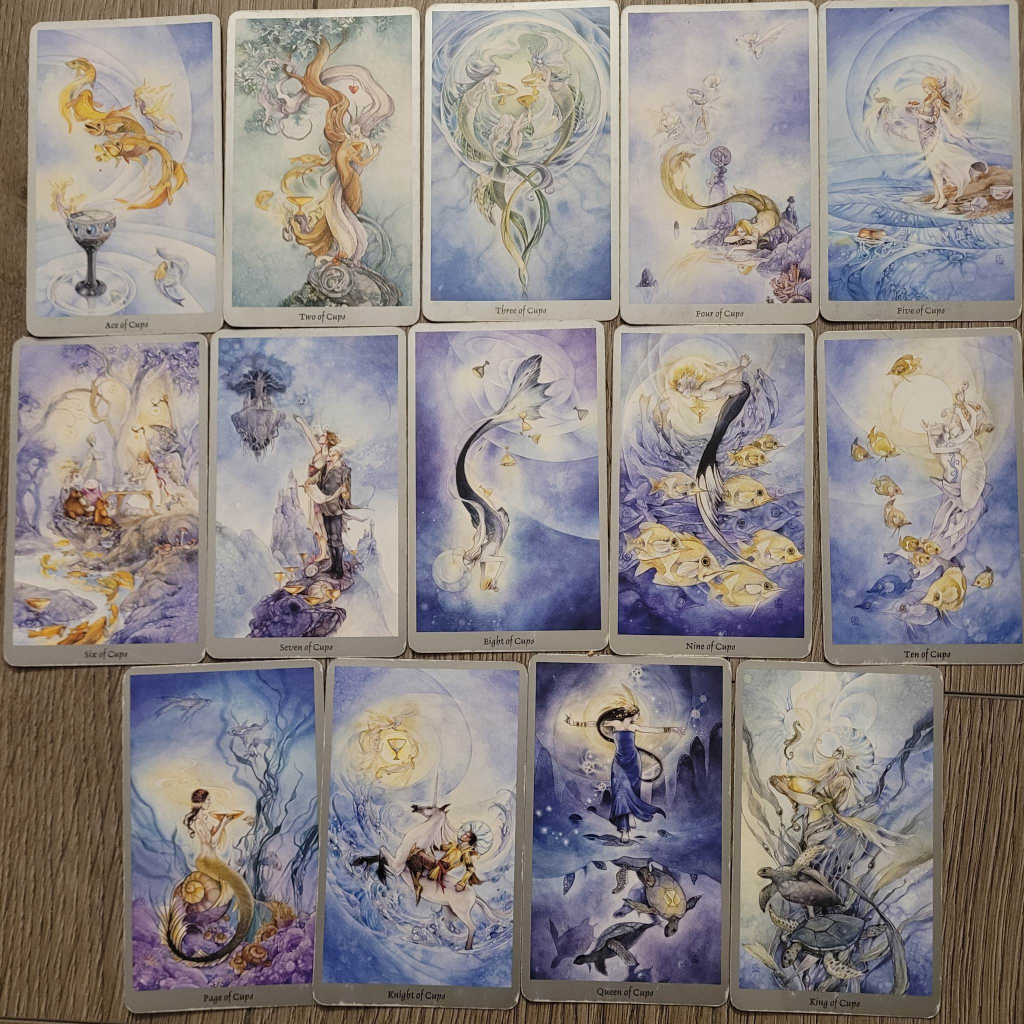
Element: water
Astrological signs: Cancer, Scorpio, Pisces
The sequence of cuts is closely linked to emotions. This sequel tells the story of the birth of love of all kinds (friendship, relationship, family, etc.). The cards in the suite are closely related to all things emotional.
The suit begins with the Ace of Cups which represents emerging emotions. It’s the beginning of a new relationship, it’s the feelings in the embryonic state. This is when the seeker re-opens to emotions and releases any emotional baggage from the past. New relational possibilities are offered and the consultant must choose whether he wishes to seize these opportunities or not.
The 2 of Cups represents the beginning of a new relationship, or at least the possibility of starting this new relationship. That is, the consultant chooses to pursue one or more of the opportunities presented by the ace of cups. It can then be any type of relationship, sentimental, professional, friendly, etc. The relationship is however in its infancy, it is an opportunity that could eventually develop into something more serious, it is the beginning of a new adventure.
The 3 of Cups represents celebration. This is a card that indicates a happy and abundant social situation. The consultant is surrounded by people with whom he feels comfortable and with whom he wants to celebrate. The beginning of a relationship initiated by the 2 of Cups leads the seeker to want to continue exploring their social circle, either to introduce their loved ones to this new relationship, or because they want to continue exploring their options. This social abundance can lead to wanting to try different approaches and different experiences.
The 4 of cups represents the consequence of the 3 of cups. When the consultant comes to saturate his emotions with too many different experiences and too many options, he can no longer see what is in front of him. He then comes to a certain emotional confusion where he finds himself jaded by everything. Too many options can make you want to withdraw into yourself. The consultant is then so overloaded with different possibilities that he can no longer even differentiate what will really bring him satisfaction, even if it is directly under his nose.
The 5 of Cups represents emotional disappointment. The consultant faces major obstacles in his love life and then feels lost. It is that he did not manage to distinguish in time what could have brought him satisfaction, or else he did not act as he should have. This card is the logical continuation of the 4 of cups, when the consultant cannot recognize in time what he needs in relational terms. Perhaps for lack of confidence, or because he did not know how to define precisely what he wanted and expected from a relationship.
The 6 of Cups represents the return to basics. After the obstacles and disappointments of the 5 of Cups, the seeker is called upon to return to the basics, to simple little pleasures. This card is often represented with a child, because it is for the consultant to return to his child’s heart, to find this simplicity which once brought him joy. It is a question of rediscovering the important and essential values for happiness, these values which it sometimes happens to override. It is often in simplicity that we manage to find true joy and this card reminds the consultant that it is essential to find simple happiness before embarking on a new adventure. This card can also symbolize the desire of the consultant to have a child or that a child is present in his life.
The 7 of Cups represents choice. The consultant then finds himself faced with a multitude of possibilities and it is up to him to select those that will bring him the most in the long term. He is then called upon to remember the lessons of the 6 of Cups and to apply them when he makes his final choice. Because some options are good and will eventually bring long-term success and stable happiness, but other choices will not have the same result. They are only there to test the consultant and see if he has learned from his past mistakes.
The 8 of Cups represents letting go. The consultant is then called upon to leave behind him the painful experiences of the past in order to focus on the future. It is impossible to really progress if one is constantly attached to the past and this is what this card wants to remind the consultant. After his choice of the 7 of Cups, if he really wants to move forward and make the most of the new opportunities available to him, he must cut ties with the negative emotional attachments of the past. It is only by leaving behind him the failures of before that he can really give a chance to the future.
The 9 of Cups represents dreams and achieving goals. The consultant suddenly finds himself close to success. However, it is up to him to distinguish the reality of his wishes. It often happens that in our desire to want to succeed and achieve a particular goal, it is difficult to really separate things. Is a situation really ideal where this is just an extension of our unfinished dreams? The consultant is then led to ask himself if what he is living or pursuing will really bring him emotional satisfaction in the long term or if his reality is only the reflection of the dreams and ideal stories that he projects there in spite of himself.
The 10 of Cups represents the attainment of ultimate emotional satisfaction. The situation of the consultant is stable and allows him to settle permanently. It is success and sentimental happiness. He has managed to build a relationship that uplifts him spiritually, emotionally and personally. The consultant managed to find an ideal partnership that will last over time. All traces of disappointment and past failures are now gone and give way to happiness and success.
The Page of Cups represents a curious and adventurous individual or energy. He is someone who is open-minded to new feelings and different possibilities. The valet is creative and not afraid to show his emotions to others. He is a go-getter and eager to try new things and let himself be led where his heart guides him. He is ready to go where his intuition takes him, even if it takes him to totally unexpected places.
The Knight of Cups represents a charming and seductive individual or energy. He is someone who lets his heart guide him and listens to his emotions. He tends to listen to his heart, even if it doesn’t always make sense. It represents the charmer, who likes to pursue different opportunities. This makes him a pleasant person, but not always reliable. It’s because the Knight of Cups is a volatile person. He only listens to his heart and tends to put his own interests and wishes first.
The Queen of Cups represents a generous and loving individual or energy. He is someone who wears his heart on his sleeve and who constantly wants to help his neighbor. The queen is a sensitive person and in tune with her feelings. She is empathetic and often puts the well-being of others before her own. In fact, his priority is to make sure everyone gets the love they need. You can always count on her to be there and help when needed. This is a stable, secure and emotionally mature figure.
The King of Cups represents an individual or energy in tune with their emotions. He is stable and knows what he wants and seeks in emotional terms. He is a partner who can be trusted, because unlike the knight, he listens to his heart while being emotionally mature enough to take into consideration his own well-being and that of others. The king is a life partner who delights in helping out and knowing that those around him are happy and content. He could never be happy if his loved ones are in trouble. He will then do everything in his power to provide advice and become the agent of the necessary changes.
Conclusion
In conclusion, mastering the art of reading the four suits of tarot can be both intriguing and illuminating. Just like learning to ride a unicycle or solve a Rubik’s cube, it may seem daunting at first, but with practice, patience, and a sprinkle of intuition, you’ll be decoding the mysteries of the tarot in no time!
As you delve into the world of tarot, you’ll come to appreciate the unique symbolism and rich history behind each of the four suits – Cups, Swords, Pentacles, and Wands. From emotional matters to intellectual challenges, material concerns to creative endeavors, the tarot offers a colorful tapestry of insights and guidance that can both amuse and amaze.
But remember, while the tarot can be a powerful tool for self-reflection and divination, it’s not a crystal ball that predicts the winning lottery numbers or reveals your next Tinder match. So, keep your expectations in check and approach the tarot with an open mind and a sense of humor. After all, what’s the harm in giggling at the sight of a cheeky-looking Page of Wands or a mischievous Devil card?
